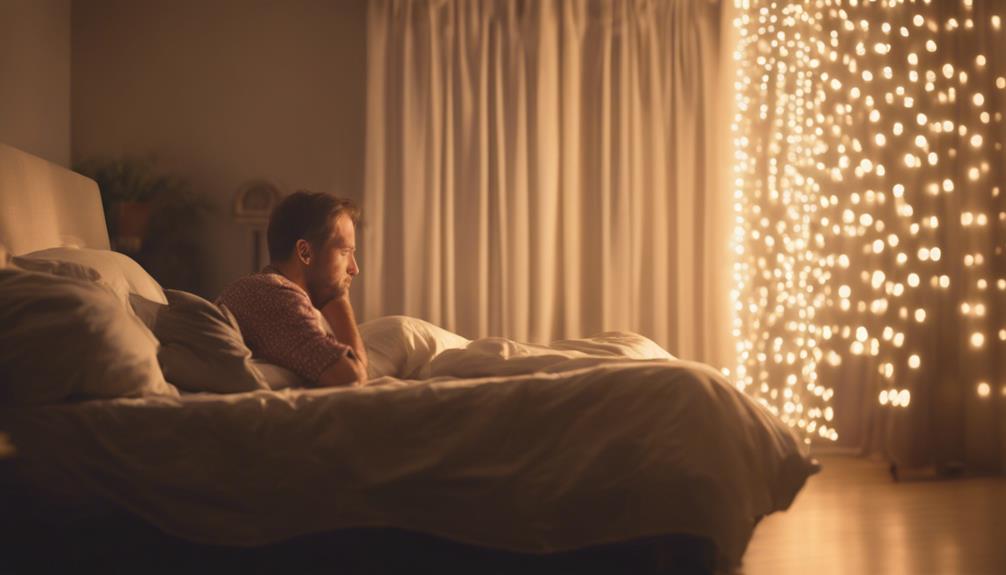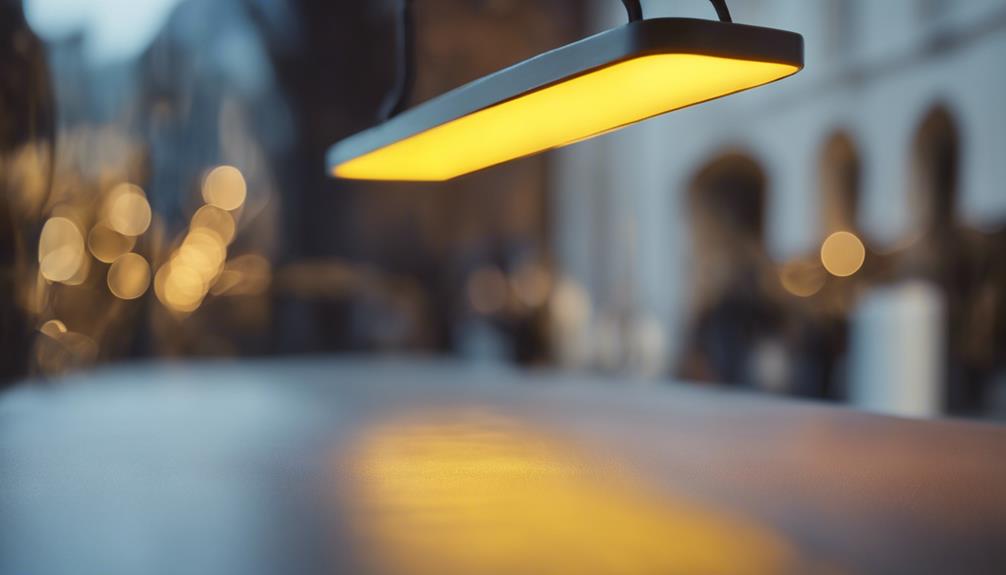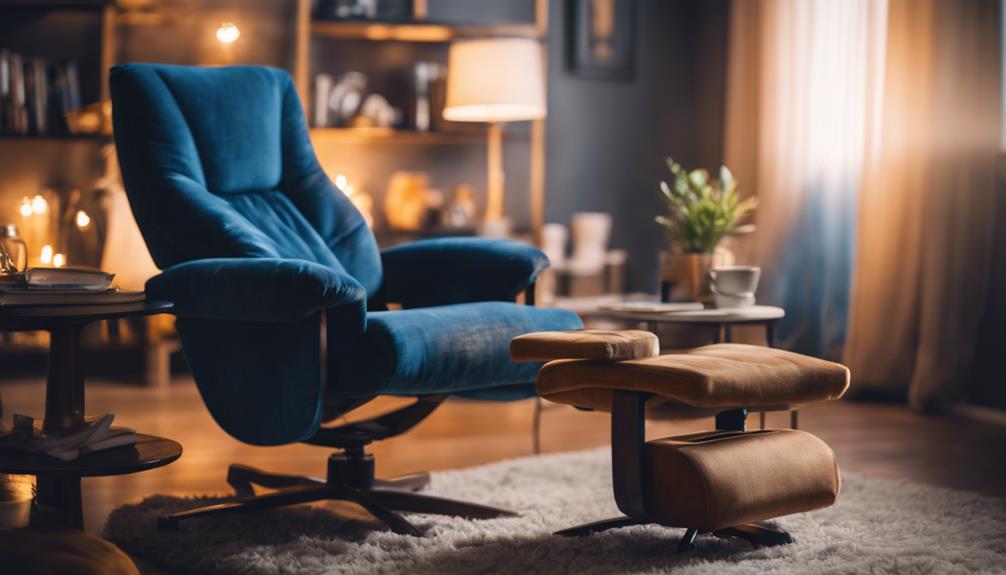LED lighting has the potential to affect health, potentially causing light sensitivity symptoms in some individuals. These symptoms may include eye pain, headaches, and difficulty tolerating light. Factors such as brightness, flickering, and color temperature can worsen these issues. Adjusting the brightness of LED lights and choosing warmer toned bulbs may help reduce discomfort. On the other hand, cooler shades of white light could lead to more severe reactions. It is advisable to seek professional advice for personalized solutions. Mr. Electric specializes in lighting solutions and can provide valuable insights on how LED lighting impacts health and the most effective ways to manage light sensitivity symptoms.
Key Takeaways
- LED lighting can trigger symptoms like headaches and eye strain in sensitive individuals.
- Blue-rich LED lights can disrupt sleep patterns and exacerbate health issues.
- Managing LED brightness, color temperature, and flickering is crucial for health.
- Seek professional advice for personalized solutions to alleviate LED light sensitivity.
- Proper adjustments like dimmers and warmer toned bulbs can reduce discomfort and health risks.
Understanding LED Light Sensitivity
Understanding LED light sensitivity involves recognizing the range of symptoms that individuals may experience when exposed to LED lighting. For some people, the cooler shades of white light, particularly in the blue-green spectrum, can trigger adverse reactions. This sensitivity to blue light can lead to various symptoms such as eye pain, headaches, light intolerance, squinting, burning or watering of the eyes, inflammation, and migraines.
It's essential to note that the brightness and flickering of LED lights can exacerbate these symptoms in individuals with light sensitivity. As a result, managing LED light sensitivity may require adjustments like using dimmer switches or opting for warmer toned LED bulbs to lessen the impact of blue light exposure. Seeking professional solutions from experts like Mr. Electric could also be beneficial for those struggling with LED light sensitivity.
Common Symptoms of Light Sensitivity

Common symptoms of light sensitivity caused by LED lighting may include:
- Eye pain
- Excessive squinting
- Headaches
This discomfort, also known as photophobia, can lead to:
- Burning or watering of the eyes
- Inflammation
Individuals sensitive to light might also experience:
- Vertigo
- Dizziness
- A strong aversion to bright light sources like LEDs.
Symptoms to Watch
Symptoms of light sensitivity from LED lighting can manifest as headaches, migraines, eye strain, blurred vision, and discomfort glare. These symptoms can have a notable impact on daily life and productivity. To watch for signs of light sensitivity, individuals should pay attention to:
- Persistent headaches
- Eye strain and fatigue
- Sensitivity to bright light
- Blurred vision
- Discomfort glare
These symptoms can vary in intensity and duration depending on the individual and the level of exposure to LED lighting.
It's crucial to consult with a healthcare professional if these symptoms persist or worsen to determine the best course of action for managing light sensitivity effectively.
Impact on Health
Exposure to LED lighting can lead to a range of health issues associated with light sensitivity, including eye pain, headaches, and light intolerance. LED light sensitivity, also known as photosensitivity, can cause discomfort such as burning or watering of the eyes, inflammation, and migraines in sensitive individuals. Symptoms like eye pain, squinting, and headaches can be triggered by exposure to LED lighting, especially in the blue-green spectrum.
Light intolerance from LED lights may worsen underlying conditions like migraines, chronic headaches, brain injuries, and eye issues. It's essential to be aware of these health implications when considering the impact of LED lighting on individuals with light sensitivity. Proper management strategies can help alleviate these symptoms and improve overall well-being.
Managing Light Sensitivity
Experiencing discomfort such as eye pain, excess squinting, and headaches can signal light sensitivity, often aggravated by exposure to LED lighting. When managing light sensitivity, individuals may encounter these common symptoms:
- Eye pain
- Excess squinting
- Burning and watering of the eyes
- Inflammation
- Headaches
Light sensitivity can be triggered by the brightness of LED lights, exacerbating symptoms like migraines and vertigo. It often accompanies underlying medical conditions such as chronic headaches or eye problems.
Home management strategies include reducing lighting intensity with dimmer switches, shades, and diffusers. Opting for warmer toned LED light bulbs in the 2,000-3,000 Kelvin range can help alleviate discomfort for those with light sensitivity.
Impact of LED Brightness on Health

The intensity levels of LED lighting can greatly impact an individual's health, particularly for those sensitive to light. High brightness from LED bulbs can exacerbate symptoms of light sensitivity, leading to issues such as migraines, eye strain, discomfort glare, and headaches. Chronic exposure to intense LED brightness emitting blue light can also disrupt sleep patterns and circadian rhythms, affecting overall well-being. To mitigate these effects, managing LED brightness through the use of dimmers, diffusers, and warmer-toned bulbs (2,000-3,000 Kelvin) is recommended to reduce discomfort for individuals with light sensitivity.
| Effects of LED Brightness | Impact on Health |
|---|---|
| Worsening light sensitivity | Triggering migraines |
| Eye strain and discomfort | Exacerbating headaches |
| Disrupted sleep patterns | Impacting circadian rhythms |
Flickering Effects of LED Lighting

The flickering of LED lighting, especially at higher frequencies, poses potential health risks, such as headaches and migraines, particularly for those with sensitivity to light. Some important points to take into account regarding the flickering effects of LEDs include:
- LED lighting can flicker at a higher frequency than other sources, potentially causing discomfort.
- The flicker effect of LEDs, especially when dimmed, can worsen symptoms of light sensitivity.
- Liquid crystal display (LCD) screens using LED backlighting flicker at a rate of 60 times per second, which may be problematic for certain individuals.
- Exposure to flickering LEDs from computer and TV screens might trigger migraine attacks in susceptible individuals.
- Managing LED flickering effects is essential for those with light sensitivity to prevent potential health issues.
It is vital to address these flickering effects to safeguard the well-being of individuals, especially those who are sensitive to light and prone to headaches or migraines.
Color Temperature and Health Concerns

LED lighting with cooler color temperatures, leaning towards blue light, can disrupt natural sleep patterns and melatonin production, impacting overall health. Exposure to blue-rich LED lights at night might suppress melatonin levels, resulting in sleep disturbances and potential health issues.
Opting for warmer color temperatures around 2,000-3,000 Kelvin is recommended to minimize negative health effects and promote well-being.
Blue Light Exposure
Taking into account the potential health risks posed by LED lighting emitting short-wave blue and violet light, it's important to be aware of its impact on melatonin production and circadian rhythms. Blue light exposure from LEDs has the potential to disrupt sleep patterns and affect overall health. Here are some key points to bear in mind:
- Blue light from LEDs can disturb melatonin production, impacting circadian rhythms.
- LED lights emit short-wave, high-energy blue and violet light that can influence human health.
- Studies indicate that exposure to blue light from LEDs, smartphones, and devices can result in sleep disturbances and mental health issues.
- Blue light in the 470-490 nm range may be less detrimental to ocular health.
- Efforts are underway to establish guidelines that aim to minimize the negative health effects of blue light in LED technology.
Circadian Rhythm Disruption
How does exposure to blue-rich LED light impact circadian rhythms and overall health?
LED lighting with higher color temperatures, such as blue-rich light, can disrupt circadian rhythms by suppressing melatonin production. This disruption affects sleep quality and overall health.
Blue light from LED sources, especially in the evening, can interfere with the body's internal clock, leading to potential health concerns like sleep disorders, fatigue, and mood disturbances.
Shift workers and individuals exposed to bright LED lighting at night are at higher risk of circadian rhythm disruption, which can have long-term health implications.
To mitigate these negative effects, implementing warmer color temperatures in LED lighting, particularly in the evening, can help promote better sleep hygiene and support healthy circadian rhythms.
Eye Strain and Fatigue
Exposure to cooler color temperatures in lighting, particularly in the blue-green spectrum, can contribute to eye strain and fatigue. LED lighting, known for its energy efficiency, emits a higher proportion of blue light, potentially leading to discomfort for some individuals.
To alleviate eye strain and fatigue caused by LED lighting, consider the following tips:
- Opt for warmer toned LED light bulbs in the 2,000-3,000 Kelvin range.
- Use dimming options or diffusers to soften the intensity of LED lights.
- Be mindful of exposure to blue light, especially in the blue-green spectrum.
- Explore smart bulbs for customizable color temperature adjustments.
- Implement breaks and adjust lighting settings to reduce eye strain and fatigue effectively.
Managing LED Light Sensitivity at Home

To effectively manage LED light sensitivity at home, individuals can adjust lighting intensity using dimmer switches, shades, and diffusers. Lowering the brightness can help alleviate discomfort for those who are sensitive to LED light bulbs.
Choosing warmer toned LED light bulbs in the 2,000-3,000 Kelvin range may further reduce symptoms of light sensitivity. Smart bulbs provide the flexibility to adjust not only the intensity but also the color of the light, offering tailored solutions for individuals with LED light sensitivity.
It's worth noting that cooler shades of white LED light, which mimic daylight, could potentially trigger stronger reactions in those prone to light sensitivity.
For personalized assistance in managing LED light sensitivity at home, seeking guidance from professionals like Mr. Electric can lead to customized solutions that cater to specific needs and preferences. By implementing these adjustments and seeking expert advice, individuals can create a more comfortable lighting environment that minimizes the impact of LED light sensitivity.
Tips for Alleviating LED Light Discomfort

Alleviating discomfort caused by LED lighting can be achieved by adjusting the intensity using dimmer switches, shades, and diffusers. Here are some tips to help alleviate LED light discomfort:
- Use dimmer switches: Lower the intensity of LED lighting to a more comfortable level.
- Opt for shades: Install shades to diffuse the harshness of the LED light.
- Consider diffusers: Attach diffusers to LED fixtures to scatter the light more evenly.
- Choose warmer toned LEDs: Opt for LED bulbs in the 2,000-3,000 Kelvin range to reduce eye strain and headaches.
- Avoid cooler shades: Steer clear of LED lights that emit cooler shades of white, especially those resembling daylight, as they can worsen symptoms of light sensitivity.
Seeking Professional Help for Light Sensitivity

When experiencing light sensitivity, individuals can seek professional help from an eye doctor who can provide guidance on managing symptoms and potential treatments. Additionally, considering the use of light filters or specialized lenses may offer relief for those affected by LED light sensitivity.
Professional assistance can offer tailored solutions to address specific concerns related to light sensitivity and improve overall comfort levels.
Consult Eye Doctor
Seeking professional help from an eye doctor is essential if you're experiencing symptoms of LED light sensitivity such as eye pain, squinting, headaches, or light intolerance. Eye doctors can provide personalized recommendations to manage LED light sensitivity and reduce discomfort.
Seeking professional help can lead to customized solutions such as using dimmer switches, shades, or warmer toned LED bulbs. Mr. Electric, a global franchise specializing in electrical services, offers expertise in addressing light sensitivity issues.
Professional guidance can help individuals create a more comfortable lighting environment and alleviate symptoms of LED light sensitivity.
Consider Light Filters
Light filters offer a practical solution for reducing discomfort caused by LED light sensitivity by adjusting the color temperature and intensity of the light. Professional help from experts like Mr. Electric can provide customized solutions for managing symptoms of light sensitivity.
Using dimmer switches, shades, and diffusers can lower the intensity of LED lighting, making it more comfortable for individuals with light sensitivity. Choosing warmer toned LED light bulbs in the 2,000-3,000 Kelvin range may alleviate symptoms of light sensitivity and reduce discomfort.
Smart bulbs offer the flexibility to adjust lighting intensities and colors, allowing for personalized settings that cater to individual preferences and needs. Seeking professional assistance can help individuals find the most suitable light filters and LED technology adjustments for their specific light sensitivity needs.
Mr. Electric's Expertise in Lighting Solutions

With an established presence since 1994, Mr. Electric showcases specialized expertise in providing tailored lighting solutions for both residential and commercial clients globally. They excel in addressing light sensitivity and discomfort caused by LEDs through:
- Offering customized solutions for managing light sensitivity.
- Providing expertise in understanding the light spectrum and its impact on individuals.
- Utilizing a range of products from dimmer switches to smart bulbs to cater to diverse needs.
- Leveraging their vast experience to create personalized lighting plans.
- Ensuring customer satisfaction by delivering high-quality services backed by years of industry knowledge.
Mr. Electric, a global franchise with nearly 200 locations worldwide, has been recognized for its exceptional services in electrical installations and repairs. As part of the Neighborly family, they prioritize the safety and comfort of their customers, making them a trusted choice for all lighting solutions.
Special Offers for Light-Sensitive Individuals

Mr. Electric is currently offering exclusive deals tailored to individuals sensitive to light. For those experiencing symptoms of LED light sensitivity, Mr. Electric provides customized solutions to alleviate discomfort. Lowering lighting intensity using dimmer switches, shades, and diffusers can help manage the effects of LEDs on light-sensitive individuals.
Opting for warmer toned LED light bulbs in the 2,000-3,000 Kelvin range may also reduce discomfort for this group. Smart bulbs, which allow adjustments in lighting intensities and colors, offer flexibility to address the needs of those with LED light sensitivity. Seeking professional assistance from Mr. Electric can provide tailored solutions for individuals struggling with symptoms related to LED lighting.
Frequently Asked Questions
Can LED Lights Make You Feel Sick?
LED lights can indeed cause sickness-like symptoms such as headaches, migraines, and eye strain. The flicker effect of LEDs and exposure to certain colors, especially blue light, can worsen these issues. Dimming LEDs may intensify symptoms. People with photophobia or light sensitivity are at a higher risk.
It's essential to be mindful of LED lighting's impact on health and make adjustments as needed to minimize discomfort.
Are LED Lights Harmful to Health?
LED lights can have negative effects on health. Blue light emission from LEDs can disrupt sleep patterns, potentially leading to mental health issues and exacerbating symptoms in those with psychiatric disorders.
Efforts to develop LEDs with reduced blue light aim to lessen these impacts, especially for light-sensitive individuals. Though modern and energy-efficient, LED lighting may pose health risks that need to be considered and addressed for overall well-being.
Can People Be Sensitive to LED Lights?
LED lights can indeed trigger sensitivity in some individuals. Symptoms can include eye discomfort, headaches, and aversion to bright lights. Factors like brightness and flickering play a role in exacerbating these reactions. Adjusting lighting intensity and using warmer-toned bulbs can help manage this sensitivity.
Seeking professional advice for personalized solutions is recommended for those with severe symptoms. LED light sensitivity is a real concern for some people, impacting their daily comfort and well-being.
Do LED Lights Affect the Brain?
LED lights can impact the brain by suppressing melatonin production, disrupting circadian rhythms, and potentially leading to sleep disturbances.
Exposure to blue light emitted by LEDs can affect mental health, particularly in teenagers.
Efforts are being made to reduce the negative effects of blue light on the brain.
The LED industry is developing customizable lights with reduced blue light to mitigate these potential impacts on brain function.
Conclusion
To sum up, LED lighting can potentially cause discomfort and health issues for some individuals due to factors such as brightness, flickering effects, and color temperature.
It's important to be aware of these potential risks and take steps to alleviate any discomfort, such as adjusting lighting settings or seeking professional help.
With Mr. Electric's expertise in lighting solutions and special offers for light-sensitive individuals, finding a solution to LED light sensitivity is possible.




